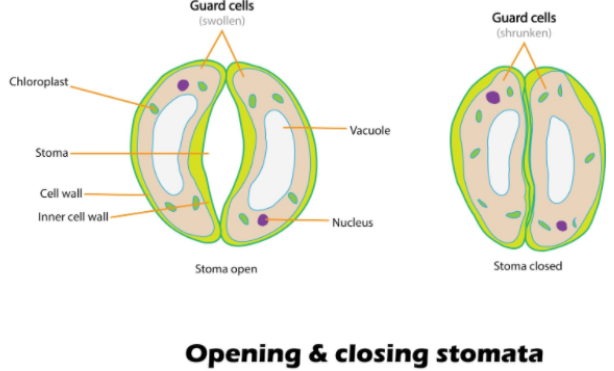Answer
424.2k+ views
Hint: These pores are responsible for the interaction between the internal plant system and the environment, working on different processes such as photosynthesis process and transpiration stream. This found on the epidermis of different plant organs made up of parenchymatous cells are pores that always remain open.
Complete answer:
Stomata structures are small pores on the surfaces of leaves, stems and parts of angiosperm flowers and fruits, formed by a pair of specialized epidermal cells, which are found in the surface of aerial parts of most higher plants. Due to the controlling of the exchange of water vapour and carbon dioxide between the interior of the leaf and the atmosphere; the photosynthesis, the transpiration stream, the nutrition and the metabolism of land plants are in different ways related to the opening and closing movements of the stomata.
Lenticels are present on fruit surfaces, such as mango, apple, and avocado. Lenticels allow the exchange of gases between the environment and the internal tissue spaces of the organs. They permit the entrance of oxygen as well as the output of carbon dioxide and water vapor. In apple fruit, lenticels account for up to 21 percent of the transpiration.

Additional Information: -In a species-specific pattern, the phellem is interspersed with enticels, aerenchymatous cork areas which are regarded as paths for the exchange of water vapour, oxygen, and carbon dioxide between inside and outside.
-The phellem–phellogen complex is called the periderm. It belongs to the secondary plant body and represents the new barrier between the secondary stem and the atmosphere.
-In most instances the lenticels are partly filled with cells, densely packed and originating from the phellogen.
-An active cork cambium gives rise to loosely packed cork cells, enabling gaseous exchange and preventing microbial infection of the plant organ.
So, the correct answer is, ‘Stomata and lenticels.’
Note: -The isolated phellem consisted solely of heavily suberized cells, organized in typical radial rows, with the connecting middle lamellae completely intact.
-The inability to close the substomatal cavity with phellem caused the lenticel cavity to enlarge as the fruit grew and resulted in the forming of an atypical lenticel.
Complete answer:
Stomata structures are small pores on the surfaces of leaves, stems and parts of angiosperm flowers and fruits, formed by a pair of specialized epidermal cells, which are found in the surface of aerial parts of most higher plants. Due to the controlling of the exchange of water vapour and carbon dioxide between the interior of the leaf and the atmosphere; the photosynthesis, the transpiration stream, the nutrition and the metabolism of land plants are in different ways related to the opening and closing movements of the stomata.
Lenticels are present on fruit surfaces, such as mango, apple, and avocado. Lenticels allow the exchange of gases between the environment and the internal tissue spaces of the organs. They permit the entrance of oxygen as well as the output of carbon dioxide and water vapor. In apple fruit, lenticels account for up to 21 percent of the transpiration.

Additional Information: -In a species-specific pattern, the phellem is interspersed with enticels, aerenchymatous cork areas which are regarded as paths for the exchange of water vapour, oxygen, and carbon dioxide between inside and outside.
-The phellem–phellogen complex is called the periderm. It belongs to the secondary plant body and represents the new barrier between the secondary stem and the atmosphere.
-In most instances the lenticels are partly filled with cells, densely packed and originating from the phellogen.
-An active cork cambium gives rise to loosely packed cork cells, enabling gaseous exchange and preventing microbial infection of the plant organ.
So, the correct answer is, ‘Stomata and lenticels.’
Note: -The isolated phellem consisted solely of heavily suberized cells, organized in typical radial rows, with the connecting middle lamellae completely intact.
-The inability to close the substomatal cavity with phellem caused the lenticel cavity to enlarge as the fruit grew and resulted in the forming of an atypical lenticel.
Recently Updated Pages
Mark and label the given geoinformation on the outline class 11 social science CBSE

When people say No pun intended what does that mea class 8 english CBSE

Name the states which share their boundary with Indias class 9 social science CBSE

Give an account of the Northern Plains of India class 9 social science CBSE

Change the following sentences into negative and interrogative class 10 english CBSE

Advantages and disadvantages of science

Trending doubts
Which are the Top 10 Largest Countries of the World?

Fill the blanks with the suitable prepositions 1 The class 9 english CBSE

Difference between Prokaryotic cell and Eukaryotic class 11 biology CBSE

Differentiate between homogeneous and heterogeneous class 12 chemistry CBSE

How do you graph the function fx 4x class 9 maths CBSE

The Equation xxx + 2 is Satisfied when x is Equal to Class 10 Maths

Select the word that is correctly spelled a Twelveth class 10 english CBSE

Give 10 examples for herbs , shrubs , climbers , creepers

What organs are located on the left side of your body class 11 biology CBSE



